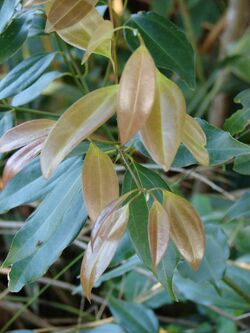Biology:Cinnamomum burmannii
| Indonesian cinnamon | |
|---|---|

| |
| Scientific classification | |
| Kingdom: | Plantae |
| Clade: | Tracheophytes |
| Clade: | Angiosperms |
| Clade: | Magnoliids |
| Order: | Laurales |
| Family: | Lauraceae |
| Genus: | Cinnamomum |
| Species: | C. burmannii
|
| Binomial name | |
| Cinnamomum burmannii (Nees & T.Nees) Blume[2]
| |
Cinnamomum burmannii (or Cinnamomum burmanni), also known as Indonesian cinnamon, Padang cassia, Batavia cassia, or korintje, is one of several plants in the genus Cinnamomum whose bark is sold as the spice cinnamon. The most common and cheapest type of cinnamon in the US is made from powdered C. burmannii.[3] C. burmannii oil contains no eugenol,[4] but higher amounts of coumarin than C. cassia and Ceylon cinnamon with 2.1 g/kg in an authenticated sample, and a mean of 5.0 g/kg in 8 samples tested.[3] It is also sold as quills of one layer.[4]
Description
Cinnamomum burmannii is an evergreen tree growing up to 7 m in height with aromatic bark and smooth, angular branches.[5] The leaves are glossy green, oval, and about 10 cm (3.9 in) long and 3–4 cm (1.2–1.6 in) wide.[6] Small yellow flowers bloom in early summer,[7] and produce a dark drupe.[5]
Distribution
Cinnamomum burmanii is native to Southeast Asia and Indonesia.[8] It is normally found in West Sumatra and western Jambi province, with the Kerinci region being especially known as the center of production of quality, high essential-oil crops. C. burmanii grows in wet, tropical climates, and is an introduced species in parts of the subtropical world, particularly in Hawaiʻi, where it is naturalized and invasive.[5][6] It was introduced to Hawaiʻi from Asia in 1934 as a crop plant.[9]
Use
Cinnamomum burmannii can extract aromatic oil from its bark, leaves and roots. The bark is also used as a cinnamon bark. The leaves can be used as a spice for preserved food and canned meat instead of laurel leaves. The core contains fat, which can be squeezed for industrial use. The wood is used for fine furniture and other fine work materials. C. burmannii is also a Chinese herbal medicine.[10]
Gallery
References
- ↑ de Kok, R. (2020). "Cinnamomum burmanni". The IUCN Red List of Threatened Species 2020: e.T145302576A145415858. doi:10.2305/IUCN.UK.2020-3.RLTS.T145302576A145415858.en. https://dx.doi.org/10.2305/IUCN.UK.2020-3.RLTS.T145302576A145415858.en.
- ↑ "Classification for Kingdom Plantae Down to Species Cinnamomum burmannii (Nees & Th. Nees) Nees ex Blume". Natural Resources Conservation Service. United States Department of Agriculture. http://plants.usda.gov/java/ClassificationServlet?source=profile&symbol=CIBU2&display=31.
- ↑ 3.0 3.1 Wang, Y.-H.; Avula, B.; Nanayakkara, N.P.D.; Zhao, J.; Khan, I.A. (2013). "Cassia Cinnamon as a Source of Coumarin in Cinnamon-Flavored Food and Food Supplements in the United States". Journal of Agricultural and Food Chemistry 61 (18): 4470–4476. doi:10.1021/jf4005862. PMID 23627682. https://cinnamonvogue.com/DOWNLOADS/Cinnamon_and_coumarin.pdf. Retrieved 2015-05-09.
- ↑ 4.0 4.1 "Indonesian Cinnamon (Cinnamomum burmannii)". Gernot Katzer’s Spice Pages. http://gernot-katzers-spice-pages.com/engl/Cinn_bur.html.
- ↑ 5.0 5.1 5.2 Motooka, Philip Susumu (2003). "Cinnamomum burmannii". Weeds of Hawaiʻi's pastures and natural areas: an identification and management guide. University of Hawaiʻi at Mānoa: College of Tropical Agriculture and Human Resources. ISBN 978-1-929325-14-6. http://www.ctahr.hawaii.edu/invweed/WeedsHI/W_Cinnamomum_burmannii.pdf.
- ↑ 6.0 6.1 Starr, Forest; Starr, Kim; Loope, Lloyd (January 2003). "Cinnamomum burmannii". Haleakala Field Station, Maui, Hawai'i: United States Geological Survey--Biological Resources Division. http://www.hear.org/starr/hiplants/reports/pdf/cinnamomum_burmannii.pdf.
- ↑ "Cinnamomum burmannii (Lauraceae)". National Tropical Botanical Garden. https://ntbg.org/plants/plant_details.php?plantid=2799.
- ↑ Wagner, Warren Lambert; Herbst, Derral R.; Sohmer, S. H. (1999). Manual of the Flowering Plants of Hawai'i. Honolulu, Hawaiʻi: University of Hawaiʻi Press. ISBN 978-0-8248-2166-1.
- ↑ Wester, Lyndon (1992). "Origin and distribution of adventive alien flowering plants in Hawaiʻi". in Stone, Charles P.. Alien plant invasions in native ecosystems of Hawaiʻi: management and research. Honolulu, Hawaiʻi: University of Hawaiʻi Press. pp. 141. ISBN 978-0-8248-1474-8. http://www.hear.org/books/apineh1992/pdfs/apineh1992ii1wester.pdf.
- ↑ "Cinnamomum burmannii (Nees & T.Nees) Blume" (in zh). iPlant.cn. http://www.iplant.cn/info/Cinnamomum%20burmannii.
External links
Wikidata ☰ Q4115136 entry













